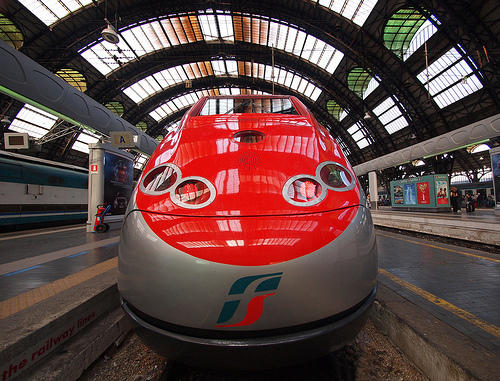Getting around - Lesson 2 - Conversation:
Alla biglietteria della stazione ferroviaria
(At the ticket window on the railway station)
(photo
by JohnPickenPhoto used
under terms of Creative Commons license.)

|
Don Smith: |
Un biglietto di andata e ritorno, seconda classe,
per Parigi sul Palatino, per favore. |
|
Bigliettaio: |
Non c'è la seconda classe in questi treni. |
|
Don Smith: |
Quanto costa un biglietto di prima? |
|
Bigliettaio: |
175.000 lire. |
|
Don Smith: |
Va bene, mi dia una prima. A che ora parte il
treno? |
|
Bigliettaio: |
Alle 19, binario 4. Arriva domani alle 8 e 30. |
|
Don Smith: |
Che ore sono adesso? |
|
Bigliettaio: |
Sono le 18 e 40. Il Suo treno parte fra 20 minuti. |
|
Don Smith: |
Scusi, dove sono i gabinetti? |
|
Bigliettaio: |
In fondo al corridoio, a destra. |
|
Don Smith: |
Tante grazie. |
|
Bigliettaio: |
Prego. S'immagini. |
Translation:
|
Don Smith: |
A round-trip ticket, second
class, to |
|
Ticket Agent: |
There isn't a second class on
these trains. |
|
Don Smith: |
How much is a first-class
ticket? |
|
Ticket Agent: |
175,000 lire. |
|
Don Smith: |
OK, give me one of the first
(class). At what time does the train leave? |
|
Ticket Agent: |
At 19:00, track 4. It arrives
tomorrow at 8:30 |
|
Don Smith: |
What time is it now? |
|
Ticket Agent: |
It's 18:40. Your train leaves
in 20 minutes. |
|
Don Smith: |
Excuse me, where are the
restrooms? |
|
Ticket Agent: |
At the end of the hallway, to
the right. |
|
Don Smith: |
Many thanks. |
|
Ticket Agent: |
You're welcome. Don't mention
it. |
Notes on conversation
1. di andata e ritorno Literally, "of going and return."
2.
Sul. su + il =
sul, "on the."
3. Che ore sono? "What time is it?" Literally, "What hours are they?"
4. Remember, the plural form of the article il is i (il gabinetto => i gabinetti)
5. Prego is "Please" and "You're welcome."
6. S'immagini is equivalent to "Don't mention it."
7. The geography of
Speed is another characteristic of the new trains. It is
possible, for example, to travel from